Contracting Fibonacci Spiral Implications for the S&P 500 Stocks Index
Stock-Markets / Stock Markets 2011 Aug 25, 2011 - 08:42 AM GMTBy: David_Petch
 One month I wrote a piece titled “Markets Trapped in a Contracting Fibonacci Spiral – Point of Singularity in 2019”. This was based upon the Fibonacci sequence, 1, 1, 2, 3, 5, 8, 13, 21, 34 etc. One item I forgot to mention was that from the 1932 bottom to 1966 was 34 years and 1966 to 1987 was 21 years...subsequently we saw the 2000 top (13 years) and then the 2008 top (8 years). This is rather more than coincidence that every major top since 1932 was identified by following a contracting Fibonacci sequence. There is no indication for how long tops last, but in general, corrections are severe...at least 40-50%.
One month I wrote a piece titled “Markets Trapped in a Contracting Fibonacci Spiral – Point of Singularity in 2019”. This was based upon the Fibonacci sequence, 1, 1, 2, 3, 5, 8, 13, 21, 34 etc. One item I forgot to mention was that from the 1932 bottom to 1966 was 34 years and 1966 to 1987 was 21 years...subsequently we saw the 2000 top (13 years) and then the 2008 top (8 years). This is rather more than coincidence that every major top since 1932 was identified by following a contracting Fibonacci sequence. There is no indication for how long tops last, but in general, corrections are severe...at least 40-50%.
Implications for quickly approaching the point of singularity implies severe volatility, so do not take positions where money is required or involve leverage...this could kill you on the downside and if not, the sleepless nights could take a toll. We are just beginning to see a sampling of how volatile things are going to get in the coming years. Timing the tops and getting out before sharp declines will be critical for ensuring no loss of capital.
At present, we have gold making new highs, which is likely to have a mid-term top put in place. The US dollar index has been basing all summer and appears set to bounce higher at some point over the course of the next 2-4 weeks. If this scenario bears fruit, it could cause a decline in precious metals, as well as some weakness in related stocks. Any weakness in precious metal stocks is expected to persist into the November time frame, while broad stock market indices are likely to have weakness extend into late November/early January 2012.
Beyond January 2012, the US dollar index is expected to put in a top around 81-83 and then subsequently decline through most of 2012 until early 2013 between 65-67 (conservative estimate). During this time, gold and silver may make new highs, but stocks are expected to do extremely well, particularly gold and silver stocks. As Treasury Bill rates remain extremely low, individuals and funds will require trying to find new sources of investment income to meet their requirements. At some point, this will fly into precious metal stocks, as the price of gold is now too much for most people run out and buy.
When 2013 does arrive, no one knows the date that a top will occur...history puts the top in place sometime between February and March, but it could occur later. When huge volume hits the market with no increase in share prices, this will be one HUGE INDICATION that a top has been put in place. The expected 2013 top is likely to be similar to 2008, except far more rapid in its decline. It likely will be a very sharp crash that takes 12-18 months to find a bottom. If commodity prices move higher (i.e. Oil), then this will at some point pop another more recent bubble and cause short-term deflation. At some point in 2013-2014, interest rates will likely begin to rise as governments require more financial stimulus to keep things propped up. Under a deflation scenario, gold and silver will likely decline in price, albeit not as severely as stocks.
Time going forward between now and early 2013 will represent a window of opportunity to generate extra cash to pay down bills and live off of when the wrath of 2013-2014 hits. These two years will occur during the first two years of the US Presidential Cycle, so they naturally will be “soft years”. When the bottom of the 2013 decline hits, there should be a strong rebound during the latter part of 2014 into 2016, which again will be met by a huge top and a subsequent sell-off.
Analysis of the S&P 500 Index today will be woven into the above theme to try and more accurately describe what to expect, on the request of several subscribers over the course of the past two weeks.
Update of the S&P 500 Index
The daily chart of the CBOE Options equity put/call ratio is shown below, with the S&P 500 Index denoted in black. The ratio closed at 1.04, again indicating an extremely oversold reading which in turn suggests that a bottom is forming. For this chart and this chart only, the %K above the %D is a sign of general weakness in the broad stock market indices, while a move beneath is a sign of strength. At present, the %K is above the %D, suggestive that extreme volatility seen during the past few weeks is likely to persist for another 1-2 weeks within a trading range of 1100-1200.
Figure 1
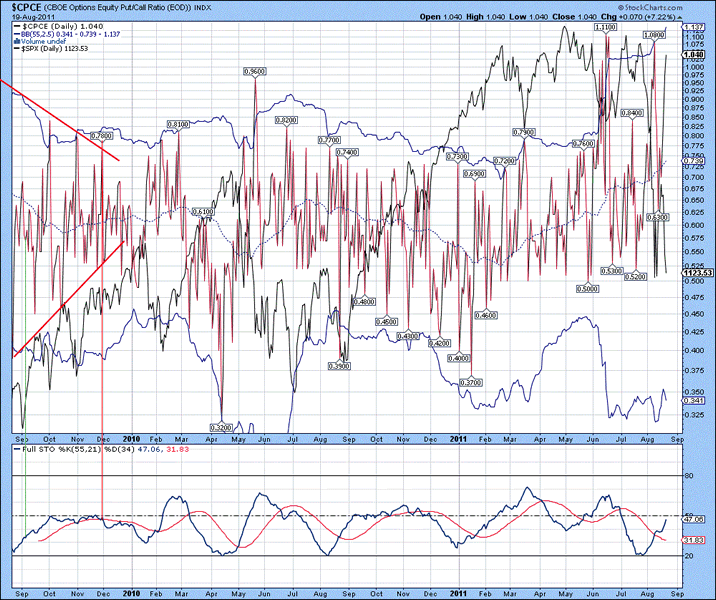
The daily chart of the S&P 500 Index is shown below, with the lower 21 and 34 MA Bollinger bands in close proximity to the index. The lower 55 MA Bollinger band continues to decline, suggestive that a bottom is looming. Full stochastics 1, 2 and 3 are shown below in order of descent, with the %K above the %D in 1 and beneath the %D in 2 and 3. Extrapolation of the %K trend in stochastics 1 and 2 suggest that a tradeable bottom is not likely to be put in place for at least 7-10 trading days...sometime before September 10th appears to be a reasonable expectation. Upper 34 and 55 MA Bollinger bands continue to move up well above the index suggestive that at least 3-4 months will be required to consolidate this decline. This fits with a bottom in the broad stock market indices due later in 2011/early 2012.
Figure 2
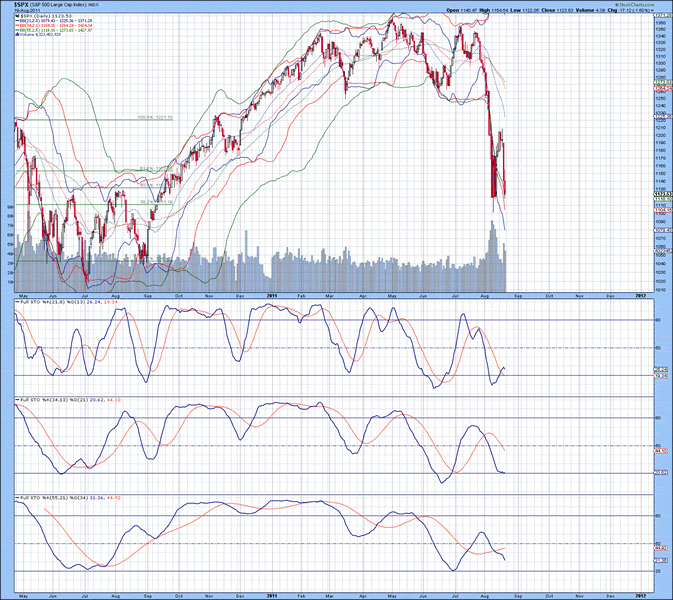
The weekly chart of the S&P 500 Index is shown below, with Fibonacci price retracements of the 2008 bottom till recent highs added, as well as Fibonacci arcs. At present, there is strong support at the 38.2% retracement level. The index had an excursion beyond the lower 21 and 34 MA Bollinger bands, indicating that a low likely has been put in place, with a bottom not due until sometime in Decemberish (A bottom referring to the end of the correction before heading higher). Full stochastics 1, 2 and 3 are shown below in order of descent, with the %K beneath the %D in all three instances. Extrapolation of the %K trend in stochastics 1 and 2 suggests that a bottom is not likely to be put in place until late December/early January 2012. Once this bottom is put in place, 2012 should see new highs put in place later in the year.
Figure 3
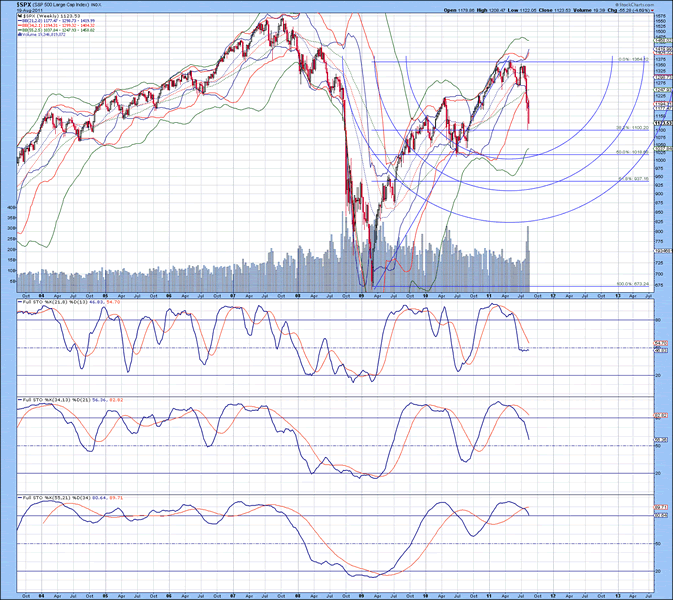
The monthly chart of the S&P 500 Index is shown below, with the lower 55 MA Bollinger band still drifting sideways, suggestive that a longer-term correction is not likely to be put in place until at least 12-18 months out. Full stochastics 1, 2 and 3 are shown below in order of descent, with the %K beneath the %D in 1 and above the %D in 2 and 3. Positioning of the %K in stochastic 2 and also the lower 34 MA Bollinger band near the 55 MA Bollinger band suggest collectively that a top is not due until...late 2012/early 2013. In 2000 when the crash occurred as well as 2008, the lower 34 M A Bollinger band was in closer proximity to the 21 MA Bollinger band as well as stochastic 2 at oversold levels. Neither of these occurrences can be seen in the present setup, which suggests we are experiencing a painful mid-term correction rather than a devastating style of crash as per 2000 and 2008. The crash expected in 2013 is likely to be very intense and wipe out many investors, so keep this in mind.
Figure 4
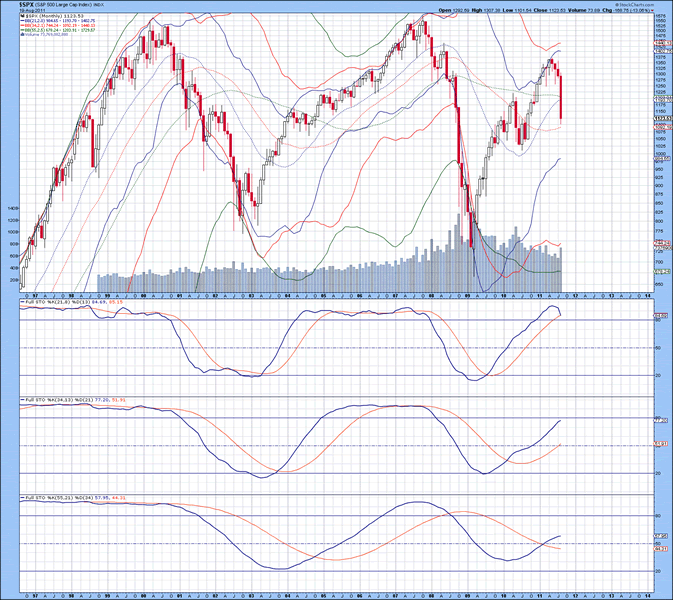
The mid-term Elliott Wave count of the S&P 500 Index is shown below, with the thought pattern forming denoted in green. Obviously the correction occurred at a much more rapid rate than expected...I was expecting a bottom around 1100-1150 to take until November, not August. Wave (Y) fit best to a diametric triangle, given that each wave was similar in time and complexity but not price. It is thought that wave (XX) is forming at present, which is expected to last until Decemberish/early January 2012. Once complete, wave (Z) is expected to last for at least 10-12 months before putting in a new high with a subsequent sharp decline to follow. The following correction should be viewed similar to wave (X) which formed during the summer months of 2010. Given the sharpness seen for wave (XX) so far, the corrective phase might take longer than expected...the longer it takes for wave (XX) to form, wave (Z) will have that much more power and upside potential.
Figure 5
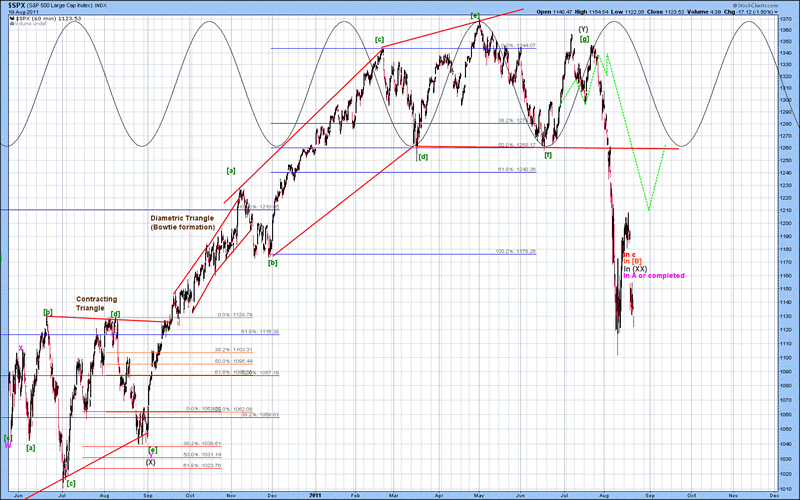
The long-term Elliott Wave count of the S&P 500 Index is shown below, with wave (XX).[B] still thought to be forming. If the pattern plays out as expected, then the decline from 2013-2014 will represent wave [C].c. Wave [B] would have taken far longer than wave [A], so this would be the perfect setup for a flat to form, which in turn implies that the 2013-2014 decline will be impulsive in nature. Wave [A].c was approximately 14 months, with wave [B] likely to be around 40-45 months. Wave [C].c then in turn is likely to be 24-30 months. This implies that the 2013-2014 decline extends into early to mid 2015. This presumption is based upon a flat structure forming...if a larger degree structure is forming, then the above thought can be negated. The same sort of implication is seen for whatever wave structure pans out...a major top in 2013 would imply major weakness extending beyond 20 months. The next 8 years are going to be very difficult, so ensure that some wealth is protected in gold and silver bullion, as well as related stocks.
Figure 6
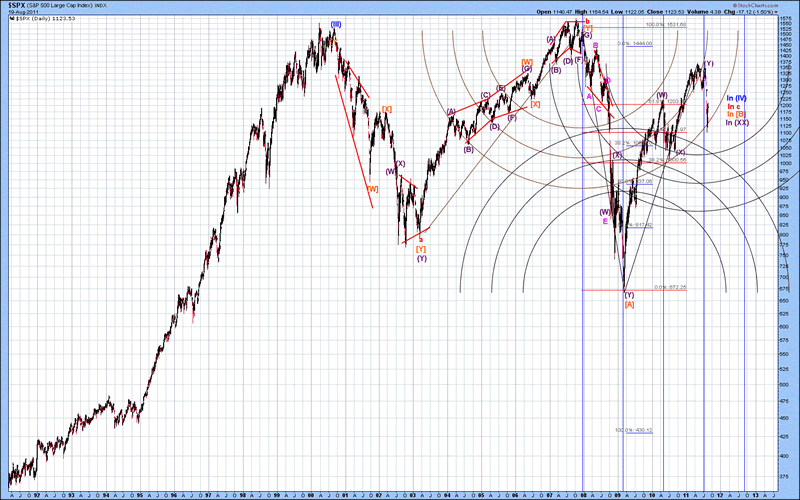
That is all for now. I will update the US dollar index tomorrow and try to tie in the 10 Year US Treasury Index.
By David Petch
http://www.treasurechests.info
I generally try to write at least one editorial per week, although typically not as long as this one. At www.treasurechests.info , once per week (with updates if required), I track the Amex Gold BUGS Index, AMEX Oil Index, US Dollar Index, 10 Year US Treasury Index and the S&P 500 Index using various forms of technical analysis, including Elliott Wave. Captain Hook the site proprietor writes 2-3 articles per week on the “big picture” by tying in recent market action with numerous index ratios, money supply, COT positions etc. We also cover some 60 plus stocks in the precious metals, energy and base metals categories (with a focus on stocks around our provinces).
With the above being just one example of how we go about identifying value for investors, if this is the kind of analysis you are looking for we invite you to visit our site and discover more about how our service can further aid in achieving your financial goals. In this regard, whether it's top down macro-analysis designed to assist in opinion shaping and investment policy, or analysis on specific opportunities in the precious metals and energy sectors believed to possess exceptional value, like mindedly at Treasure Chests we in turn strive to provide the best value possible. So again, pay us a visit and discover why a small investment on your part could pay you handsome rewards in the not too distant future.
And of course if you have any questions, comments, or criticisms regarding the above, please feel free to drop us a line . We very much enjoy hearing from you on these items.
Disclaimer: The above is a matter of opinion and is not intended as investment advice. Information and analysis above are derived from sources and utilizing methods believed reliable, but we cannot accept responsibility for any trading losses you may incur as a result of this analysis. Comments within the text should not be construed as specific recommendations to buy or sell securities. Individuals should consult with their broker and personal financial advisors before engaging in any trading activities as we are not registered brokers or advisors. Certain statements included herein may constitute "forward-looking statements" with the meaning of certain securities legislative measures. Such forward-looking statements involve known and unknown risks, uncertainties and other factors that may cause the actual results, performance or achievements of the above mentioned companies, and / or industry results, to be materially different from any future results, performance or achievements expressed or implied by such forward-looking statements. Do your own due diligence.
Copyright © 2011 treasurechests.info Inc. All rights reserved.
Unless otherwise indicated, all materials on these pages are copyrighted by treasurechests.info Inc. No part of these pages, either text or image may be used for any purpose other than personal use. Therefore, reproduction, modification, storage in a retrieval system or retransmission, in any form or by any means, electronic, mechanical or otherwise, for reasons other than personal use, is strictly prohibited without prior written permission.
David Petch Archive |
© 2005-2022 http://www.MarketOracle.co.uk - The Market Oracle is a FREE Daily Financial Markets Analysis & Forecasting online publication.



